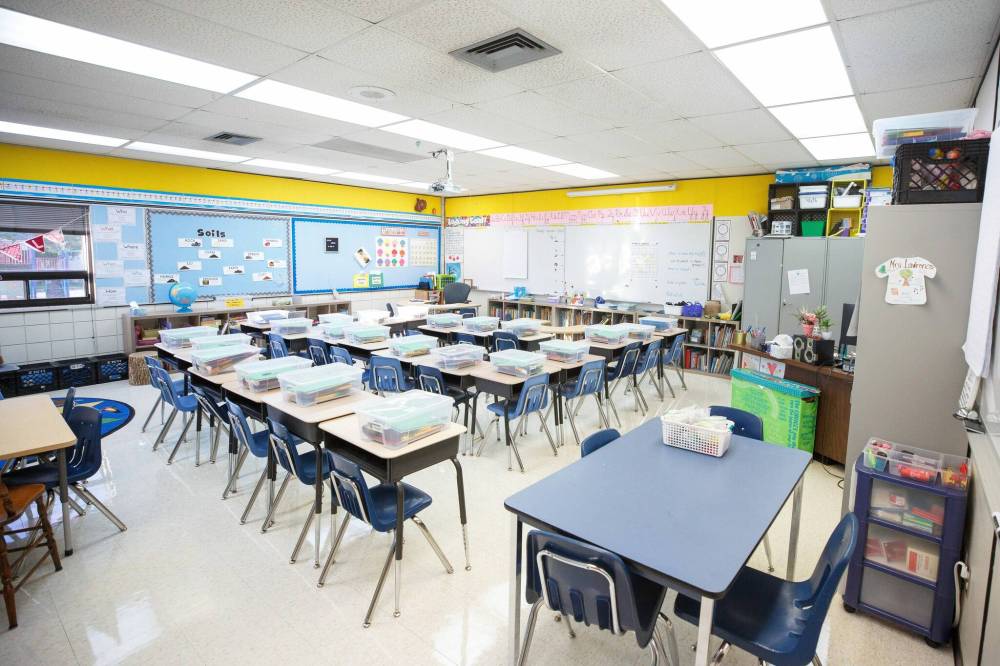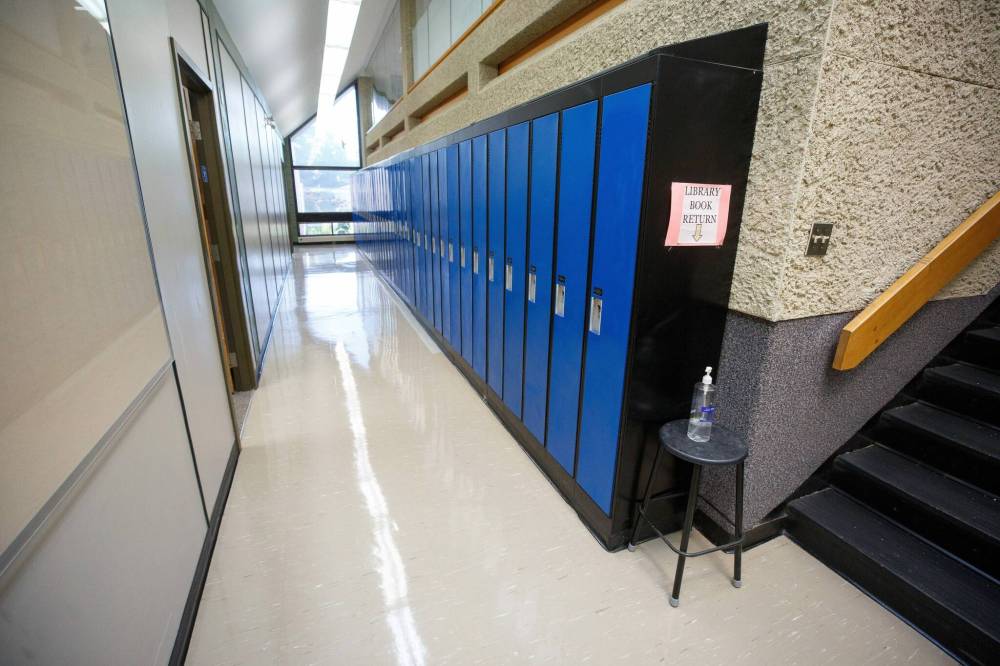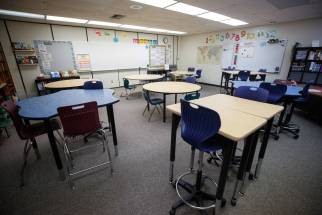Education task force report puts spotlight on chronic school absenteeism
Read this article for free:
or
Already have an account? Log in here »
To continue reading, please subscribe:
Monthly Digital Subscription
$0 for the first 4 weeks*
- Enjoy unlimited reading on winnipegfreepress.com
- Read the E-Edition, our digital replica newspaper
- Access News Break, our award-winning app
- Play interactive puzzles
*No charge for 4 weeks then price increases to the regular rate of $19.00 plus GST every four weeks. Offer available to new and qualified returning subscribers only. Cancel any time.
Monthly Digital Subscription
$4.75/week*
- Enjoy unlimited reading on winnipegfreepress.com
- Read the E-Edition, our digital replica newspaper
- Access News Break, our award-winning app
- Play interactive puzzles
*Billed as $19 plus GST every four weeks. Cancel any time.
To continue reading, please subscribe:
Add Free Press access to your Brandon Sun subscription for only an additional
$1 for the first 4 weeks*
*Your next subscription payment will increase by $1.00 and you will be charged $16.99 plus GST for four weeks. After four weeks, your payment will increase to $23.99 plus GST every four weeks.
Read unlimited articles for free today:
or
Already have an account? Log in here »
Hey there, time traveller!
This article was published 19/12/2022 (1085 days ago), so information in it may no longer be current.
More than 6,500 students — about four per cent of Manitoba’s K-12 population — went missing from school in September 2020, an alarming statistic revealed in a new report that warns COVID-19 has worsened engagement in education.
“The pandemic has produced few benefits, but it has foregrounded student absence and mental health as significant impediments to school success,” states an excerpt from “Addressing Chronic Absenteeism in Manitoba: an Action Plan for Student Presence,” which was obtained by the Free Press.
As part of its now-defunct attendance task force, the province hired a Vancouver-based firm to investigate chronic absenteeism, do a literature review on the issue and provide recommendations to address it.
Directions Evidence and Policy Research Group, whose director of research is Charles Ungerleider, a former B.C. deputy education minister, submitted its final report March 18.
The 115-page document calls on officials to take immediate action to find thousands of inactive learners: students who were previously enrolled in school, have stopped attending, and have not graduated or moved outside the province.
Plan for addressing chronic absenteeism
Between September 2019 and September 2020, during which public health officials declared an emergency and began drilling the importance of staying home when ill, roughly 6,800 public school pupils were unaccounted for.
Enrolment in the Winnipeg School Division, the most highly-populated district encompassing the capital city’s core, dropped by 3,148 students over that year.
Some of these pupils transferred or started homeschooling. Others disengaged from academics.
The report concludes truancy has a direct negative impact on achievement, graduation, post-secondary enrolment, employment, health and the likelihood of involvement with the criminal justice and social services systems.
“The impact of absenteeism on the individual and the community are socially, financially, and politically costly. The cost of doing little or nothing is much greater than the investment needed to re-engage students and their families,” the authors wrote.
MIKE DEAL / WINNIPEG FREE PRESS More than 6,500 students — about four per cent of Manitoba’s K-12 population — went missing from school in September 2020.
An urgent investigation between K-12 partners to locate students, an end to using suspension in response to absenteeism, and the increased collection of attendance data provincewide are among key recommendations.
The consultant group suggested Manitoba update its policy and practice to require an immediate and personalized response when a student has an unexcused absence and implement co-ordinated case management.
“Desperate times, desperate measures,” said Kent Dueck, executive director of Inner City Youth Alive, a faith-based resource centre that runs drop-in programs for students in the North End.
“We can’t continue to do what we’ve been doing, which is to saddle teachers with that additional responsibility – I mean, not to say that they can wash their hands of this, but I think there has to be a bigger strategy, a greater vision for re-engaging students.”
The moment a student becomes “chronically absent,” typically defined as missing 10 per cent of instructional time, a designated school team should be mandated to intervene, Dueck believes.
“We can’t continue to do what we’ve been doing, which is to saddle teachers with that additional responsibility – I mean, not to say that they can wash their hands of this, but I think there has to be a bigger strategy, a greater vision for re-engaging students.”–Kent Dueck, executive director of Inner City Youth Alive
Dueck was tapped as a community representative for Manitoba’s attendance task force when it was established in 2019. The group was disbanded in June 2022, shortly after the province received the report outlining recommendations that have yielded mixed reviews from members.
The task force, made up of bureaucrats, school division leaders and community partners, never came to a consensus that this issue is an emergency, Dueck said, noting such a label is required to prompt sudden and long-overdue progress.
“Pre-COVID, there was already lots of instability in homes and kids feeling hard pressed to get to school and anxiety-ridden — and now, what the pandemic did was dialed that up,” he added.
When the subject of suicidality came up during a recent support group he was running, Dueck said five of 14 youth participants disclosed they were actively entertaining suicidal thoughts.
The reasons for absenteeism are often nuanced, varied and tied to home life. Poverty, homelessness and a family’s negative experience with schooling, including but not limited to intergenerational trauma tied to the residential school system, may all be factors.
MIKE DEAL / WINNIPEG FREE PRESS Enrolment in the Winnipeg School Division dropped by 3,148 students between September 2019 and September 2020.
The research team who compiled recommendations for Manitoba indicated K-12 leaders can not address this issue alone, but they must create “safe, welcoming, and culturally responsive” buildings.
The report calls on schools to: bolster nutrition programs; focus on engagement with families; implement culturally relevant and responsive curriculum; provide anti-racism training to employees; and embrace restorative justice.
Community activist Sel Burrows said there is a reluctance to address the root causes of non-attendance because they are complex and it will require hard work to get involved in students’ personal lives.
Burrows, who sat on the provincial task force, said absenteeism begins when children are in elementary school and it snowballs when a student is bullied because they are behind and there is peer pressure to continue skipping.
“The issue is you have a very significant number of homes where the kids, parents, mom, grandma, whoever’s looking after them, don’t get them up in the morning and push them out the door,” he said.
Burrows said hiring more community outreach workers who are familiar, friendly faces rather than using truancy officers whose door-knocks go unanswered is critical to create momentum.
“The issue is you have a very significant number of homes where the kids, parents, mom, grandma, whoever’s looking after them, don’t get them up in the morning and push them out the door.”–Community activist Sel Burrows
Both Dueck and Burrows agreed the status quo is resulting in unacceptable outcomes and change relies upon better intergovernmental communication.
The March 2022 report recommended Manitoba Education create a unit dedicated to “student persistence and success,” while emphasizing the importance of collaboration across government departments and with non-governmental agencies.
One example included is the potential for Manitoba Employment and Income Assistance and Manitoba Justice to take on supportive roles by systematically encouraging attendance during interactions with clients.
A government spokesperson said the attendance task force’s work has transitioned to a newly-established schools and community support unit within the education department.
Consultations on a strategy to bolster student presence and a related policy are wrapping up and final recommendations will be released shortly, they wrote in an email.
maggie.macintosh@freepress.mb.ca
Twitter: @macintoshmaggie

Maggie Macintosh reports on education for the Winnipeg Free Press. Funding for the Free Press education reporter comes from the Government of Canada through the Local Journalism Initiative.
Our newsroom depends on a growing audience of readers to power our journalism. If you are not a paid reader, please consider becoming a subscriber.
Our newsroom depends on its audience of readers to power our journalism. Thank you for your support.







